Unit2 How do you come to school 课件(共26张PPT)
文档属性
| 名称 | Unit2 How do you come to school 课件(共26张PPT) | 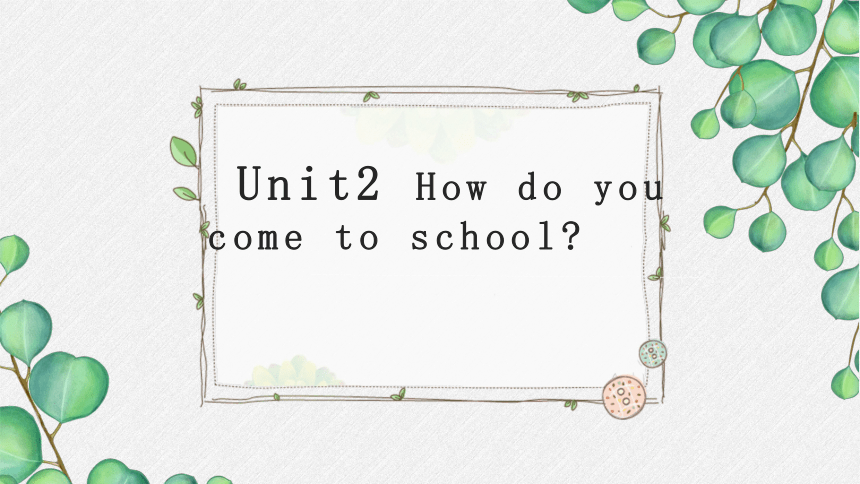 | |
| 格式 | zip | ||
| 文件大小 | 20.4MB | ||
| 资源类型 | 教案 | ||
| 版本资源 | 牛津译林版 | ||
| 科目 | 英语 | ||
| 更新时间 | 2023-01-26 13:16:00 | ||
图片预览

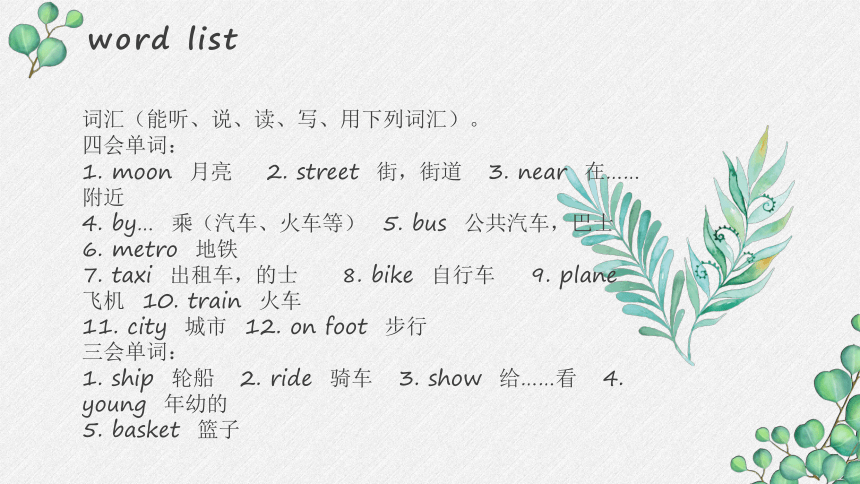

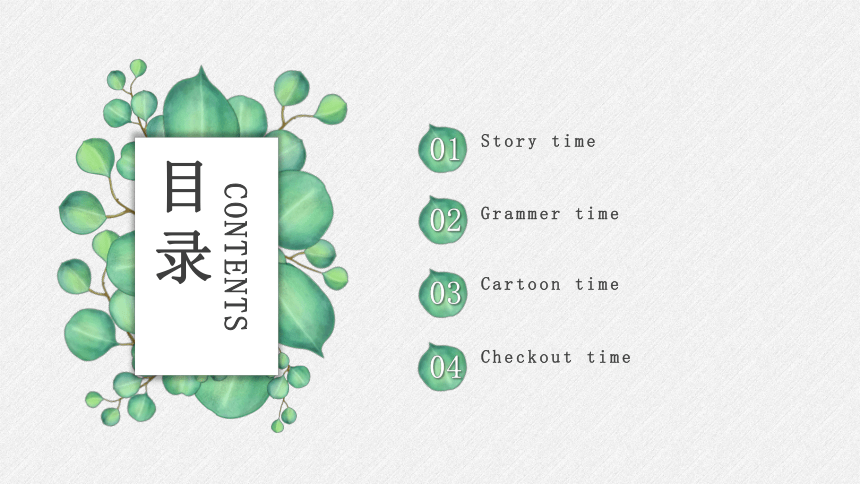

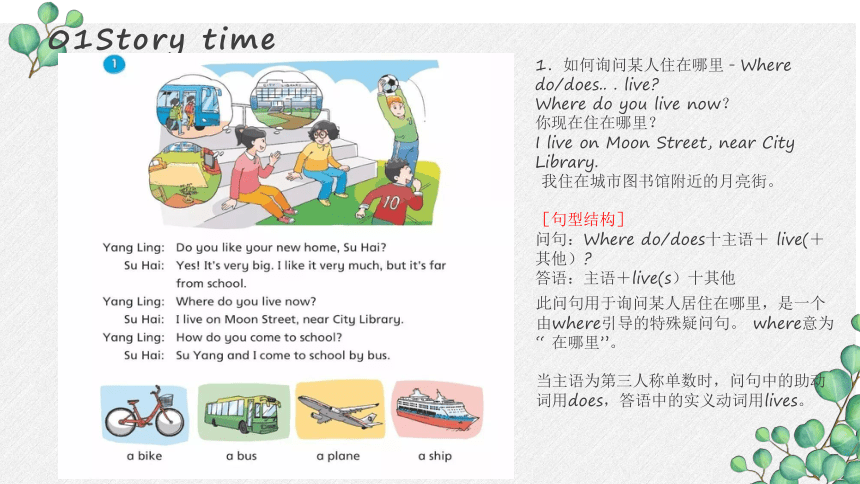
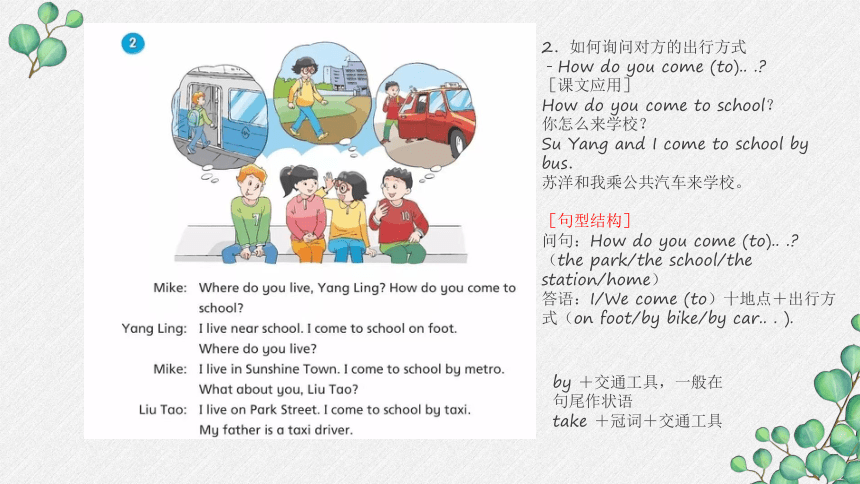

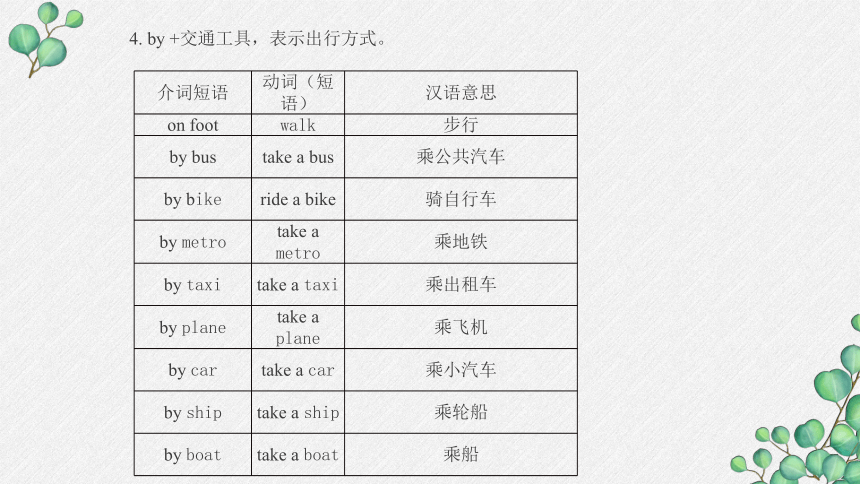
文档简介
(共26张PPT)
Unit2 How do you come to school
word list
词汇(能听、说、读、写、用下列词汇)。
四会单词:
1. moon 月亮 2. street 街,街道 3. near 在……附近
4. by… 乘(汽车、火车等) 5. bus 公共汽车,巴士 6. metro 地铁
7. taxi 出租车,的士 8. bike 自行车 9. plane 飞机 10. train 火车
11. city 城市 12. on foot 步行
三会单词:
1. ship 轮船 2. ride 骑车 3. show 给……看 4. young 年幼的
5. basket 篮子
Grammer time
Cartoon time
Story time
Checkout time
01
02
03
04
目录
CONTENTS
01 Story time
01Story time
1.如何询问某人住在哪里﹣Where do/does.. . live
Where do you live now?
你现在住在哪里?
I live on Moon Street, near City Library.
我住在城市图书馆附近的月亮街。
[句型结构]
问句:Where do/does十主语+ live(+其他)
答语:主语+live(s)十其他
此问句用于询问某人居住在哪里,是一个由where引导的特殊疑问句。 where意为“ 在哪里”。
当主语为第三人称单数时,问句中的助动词用does,答语中的实义动词用lives。
by +交通工具,一般在句尾作状语
take +冠词+交通工具
2.如何询问对方的出行方式
﹣How do you come (to).. .
[课文应用]
How do you come to school?
你怎么来学校?
Su Yang and I come to school by bus.
苏洋和我乘公共汽车来学校。
[句型结构]
问句:How do you come (to).. . (the park/the school/the station/home)
答语:I/We come (to)十地点+出行方式(on foot/by bike/by car.. . ).
2.如何询问对方的出行方式
﹣How do you come (to).. .
此问句用于询问对方的出行方式。
how:意为“怎样”,用来询问做事情的方式,位于句首,引导特殊疑问句。
do:助动词,帮助构成疑问句,无实际意义。
come (to):如果come后面所接的词为副词,则要省略to。
例如·:come here
答语:除了完整回答之外,在口语中也可以用简略形式的介词短语进行回答。
例如:
On foot.步行。
By bike. 骑自行车。
By plane. 乘飞机。
By car.乘小汽车。
[知识拓展]
怎样询问他人的出行方式
How does he /she come (to)+地点?
他/她是如何来到某个地点的?
例如:
How does she come to the park?
她怎么来公园?
How do they come (to)十地点?
例如:
How do they come to the bus station?他们怎么来公共汽车站?
4. by +交通工具,表示出行方式。
介词短语 动词(短语) 汉语意思
on foot walk 步行
by bus take a bus 乘公共汽车
by bike ride a bike 骑自行车
by metro take a metro 乘地铁
by taxi take a taxi 乘出租车
by plane take a plane 乘飞机
by car take a car 乘小汽车
by ship take a ship 乘轮船
by boat take a boat 乘船
02 Grammer time
02 Grammer time
Where do you live now
“I live+表示方位的词语”
where是特殊疑问词,用来引导特殊疑问句,其回答不能简单地回答yes或者no,而是要根据具体所问来回答,来回答。当主语是第三人称单数时,则用“Where does...live ”来提问,回答时谓语动词也相应地使用其第三人称单数形式“...lives ”。
How do you come to school
这里提问的是交通方式,回答一般用by+交通工具来回答,例如:by bus, by train等;
注意:当表示步行这种交通方式时不用by,用on foot。当主语是第三人称单数时,用“How does... come to school ”来提问,回答同样用第三人称单数来回答。
02Grammer time
语法点
1. 询问某人住在哪里的句型:
Where do/doe...live 及其回答...live/lives...
①一般情况下用“Where do...live ”和“...live...”来问和答。
②当主语是第三人称单数时,用“Where does live ”和“...lives ”来问和答。
2. 询问某人如何到某地的句型“How do/does...”及其回答“...by/on...”。
①一般情况下用“How do...”和“...by/on...”来问和答。
②当主语是第三人称单数时,用“How does ”和“...by/on...”来问和答。
3. be far from 意为“离……远”,其后接地点,反义短语为:
be near 离……近。例如:The park is near the cinema. = The park isn’t far from the cinema.
03 Sound time
03 Sound time
traffic
n.
路上行驶的车辆,交通;
交通工具;(沿固定路线的)航行,行驶,飞行;运输量;非法交易;信息流量,通信(量)
例句:1.We were stuck in a traffic jam.
我们遇上了交通阻塞。
2.Turn left at the traffic lights.
在交通信号灯处向左拐。
beep
n.(电子设备的)哔哔声;(汽车喇叭的)嘟嘟声;警笛声;
04 Cartoon time
03cartoon time
by短语表示交通方式
[课文应用]
Su Yang and I come to school by bus.
苏洋和我乘公共汽车来学校。
by意为“乘……”。
“by十交通工具”表示“乘坐…”。
“by bus”是由介词by 和名词bus构成的介词短语,意为“乗公共汽车”。
其他类似的短语还有:
by train( 乘火车), by car(乘小汽车), by plane(乘飞机)等。
例如:
开学第一天,同学们在介绍自己上学的交通方式: Amy : I go to school ——
我骑自行车去上学。
Chen Jie:I go to school ——.
我乘公共汽车去上学。
03Cartoon time
think so 这样认为
in the basket 在篮子里
04 Checkout time
04Checkout time
go there 去那里
work on a big ship 在大轮船上工作 get there 到达那里
04Checkout time
04Checkout time
一、判断下列每组单词画线部分的读音是否相同,相同的写“S”,不相同的写“D”。
( ) 1. dress train ( ) 2. tree taxi ( ) 3. trousers travel
( ) 4. city ship ( ) 5. put mushroom ( ) 6. bike ride
二、英汉互译。
1.Liu tao_____________________________________(住在阳光街上).
2.Helen_________________________________________________(想要骑自行车去公园).
3. How ______________________________________________(Bobby到达那里)
4. 我不这么认为。__________________________________
5. Let’s ______________________________ (拜访她).
6. too young_______________________
7 sit in the basket_______________________
8. think so_______________________
9. show his book to David_______________________
10. I can fly. _______________________
04Checkout time
三、单项选择
( )1.— Can you__________your new shoes___________me All right
A. show: to B. show: for C. showing
( )2. Do you like__________bikes
A. ride B. riding C. rideing
( )3.Can I watch TV now, Mum Sorry, _________can't. You have to___________books.
A. you; see B. I; read C. you; read
( )4.— Do you want__________football Yes, I do.
A. plays B. to play C, play
( )5.Why can't I go to school by bike -Because you________too young.
A. have B./ C.are
四、从Ⅱ栏中选出与I栏相对应的答句。
I Ⅱ
( )1. Are they waiting for bus A. On foot.
( )2. How does she go to work B. He's from Shanghai
( )3. What does your brother usually do at weekends C. He usually reads books.
( )4. How does the man go home D. No, they aren’t.
( )5. Where is the boy from E. She goes to work by bike.
知识点整理
一、短语:
1. your new home 你的新家 2. very much 非常
3. be far from… 离……远 4. live on Moon Street 住在月亮街
5. come to school 来学校 6. by bus 乘公共汽车
7. live near school 住在学校附近 8. live in Sunshine Town 住在阳光城
9. by metro 乘坐地铁 10. by taxi 乘坐出租车
11. a taxi driver 一位出租车司机 12. through the trees 穿过树
13. a new bike 一辆新的自行车 14. go to school 去上学
15. show his bike to Sam 展示他的自行车给Sam
16. too young 太年轻 17. think so 这样认为
18. in the basket 在篮子里 19. go there 去那里
20. work on a big ship 在大轮船上工作 21. get there 到达那里
22. go to many cities 去许多城市
二、句型(能听、说、读、写、用下列句式)。
1. Do you like your new home, Su Hai 你喜欢你的新家吗, 苏海?
解析:do是助动词,其第三人称单数形式是does,否定形式分别为:don’t 和doesn’t。助动词开头的句子是一般疑问句,一般用“Yes, do/does.”或“No, don’t/doesn’t.”来回答。
2. I like it very much, but it’s far from school.
我非常喜欢它,但是它离学校太远了。
3. Su Yang and I come to school by bus.
苏阳和我坐公共汽车来学校。
4. I live in Sunshine Town. 我住在阳光城。
5. He likes riding it in the park. 他喜欢在公园里骑它。
6 How does Sam go to school Sam 怎么去上学?
7. Bobby wants to show his bike to Sam.鲍比想要把他的自行车给山姆看。
解析:want to想要做某事,想要某物是want后面直接加某物,想要做某事“want+to+动词原形”。
感谢您的欣赏
Unit2 How do you come to school
word list
词汇(能听、说、读、写、用下列词汇)。
四会单词:
1. moon 月亮 2. street 街,街道 3. near 在……附近
4. by… 乘(汽车、火车等) 5. bus 公共汽车,巴士 6. metro 地铁
7. taxi 出租车,的士 8. bike 自行车 9. plane 飞机 10. train 火车
11. city 城市 12. on foot 步行
三会单词:
1. ship 轮船 2. ride 骑车 3. show 给……看 4. young 年幼的
5. basket 篮子
Grammer time
Cartoon time
Story time
Checkout time
01
02
03
04
目录
CONTENTS
01 Story time
01Story time
1.如何询问某人住在哪里﹣Where do/does.. . live
Where do you live now?
你现在住在哪里?
I live on Moon Street, near City Library.
我住在城市图书馆附近的月亮街。
[句型结构]
问句:Where do/does十主语+ live(+其他)
答语:主语+live(s)十其他
此问句用于询问某人居住在哪里,是一个由where引导的特殊疑问句。 where意为“ 在哪里”。
当主语为第三人称单数时,问句中的助动词用does,答语中的实义动词用lives。
by +交通工具,一般在句尾作状语
take +冠词+交通工具
2.如何询问对方的出行方式
﹣How do you come (to).. .
[课文应用]
How do you come to school?
你怎么来学校?
Su Yang and I come to school by bus.
苏洋和我乘公共汽车来学校。
[句型结构]
问句:How do you come (to).. . (the park/the school/the station/home)
答语:I/We come (to)十地点+出行方式(on foot/by bike/by car.. . ).
2.如何询问对方的出行方式
﹣How do you come (to).. .
此问句用于询问对方的出行方式。
how:意为“怎样”,用来询问做事情的方式,位于句首,引导特殊疑问句。
do:助动词,帮助构成疑问句,无实际意义。
come (to):如果come后面所接的词为副词,则要省略to。
例如·:come here
答语:除了完整回答之外,在口语中也可以用简略形式的介词短语进行回答。
例如:
On foot.步行。
By bike. 骑自行车。
By plane. 乘飞机。
By car.乘小汽车。
[知识拓展]
怎样询问他人的出行方式
How does he /she come (to)+地点?
他/她是如何来到某个地点的?
例如:
How does she come to the park?
她怎么来公园?
How do they come (to)十地点?
例如:
How do they come to the bus station?他们怎么来公共汽车站?
4. by +交通工具,表示出行方式。
介词短语 动词(短语) 汉语意思
on foot walk 步行
by bus take a bus 乘公共汽车
by bike ride a bike 骑自行车
by metro take a metro 乘地铁
by taxi take a taxi 乘出租车
by plane take a plane 乘飞机
by car take a car 乘小汽车
by ship take a ship 乘轮船
by boat take a boat 乘船
02 Grammer time
02 Grammer time
Where do you live now
“I live+表示方位的词语”
where是特殊疑问词,用来引导特殊疑问句,其回答不能简单地回答yes或者no,而是要根据具体所问来回答,来回答。当主语是第三人称单数时,则用“Where does...live ”来提问,回答时谓语动词也相应地使用其第三人称单数形式“...lives ”。
How do you come to school
这里提问的是交通方式,回答一般用by+交通工具来回答,例如:by bus, by train等;
注意:当表示步行这种交通方式时不用by,用on foot。当主语是第三人称单数时,用“How does... come to school ”来提问,回答同样用第三人称单数来回答。
02Grammer time
语法点
1. 询问某人住在哪里的句型:
Where do/doe...live 及其回答...live/lives...
①一般情况下用“Where do...live ”和“...live...”来问和答。
②当主语是第三人称单数时,用“Where does live ”和“...lives ”来问和答。
2. 询问某人如何到某地的句型“How do/does...”及其回答“...by/on...”。
①一般情况下用“How do...”和“...by/on...”来问和答。
②当主语是第三人称单数时,用“How does ”和“...by/on...”来问和答。
3. be far from 意为“离……远”,其后接地点,反义短语为:
be near 离……近。例如:The park is near the cinema. = The park isn’t far from the cinema.
03 Sound time
03 Sound time
traffic
n.
路上行驶的车辆,交通;
交通工具;(沿固定路线的)航行,行驶,飞行;运输量;非法交易;信息流量,通信(量)
例句:1.We were stuck in a traffic jam.
我们遇上了交通阻塞。
2.Turn left at the traffic lights.
在交通信号灯处向左拐。
beep
n.(电子设备的)哔哔声;(汽车喇叭的)嘟嘟声;警笛声;
04 Cartoon time
03cartoon time
by短语表示交通方式
[课文应用]
Su Yang and I come to school by bus.
苏洋和我乘公共汽车来学校。
by意为“乘……”。
“by十交通工具”表示“乘坐…”。
“by bus”是由介词by 和名词bus构成的介词短语,意为“乗公共汽车”。
其他类似的短语还有:
by train( 乘火车), by car(乘小汽车), by plane(乘飞机)等。
例如:
开学第一天,同学们在介绍自己上学的交通方式: Amy : I go to school ——
我骑自行车去上学。
Chen Jie:I go to school ——.
我乘公共汽车去上学。
03Cartoon time
think so 这样认为
in the basket 在篮子里
04 Checkout time
04Checkout time
go there 去那里
work on a big ship 在大轮船上工作 get there 到达那里
04Checkout time
04Checkout time
一、判断下列每组单词画线部分的读音是否相同,相同的写“S”,不相同的写“D”。
( ) 1. dress train ( ) 2. tree taxi ( ) 3. trousers travel
( ) 4. city ship ( ) 5. put mushroom ( ) 6. bike ride
二、英汉互译。
1.Liu tao_____________________________________(住在阳光街上).
2.Helen_________________________________________________(想要骑自行车去公园).
3. How ______________________________________________(Bobby到达那里)
4. 我不这么认为。__________________________________
5. Let’s ______________________________ (拜访她).
6. too young_______________________
7 sit in the basket_______________________
8. think so_______________________
9. show his book to David_______________________
10. I can fly. _______________________
04Checkout time
三、单项选择
( )1.— Can you__________your new shoes___________me All right
A. show: to B. show: for C. showing
( )2. Do you like__________bikes
A. ride B. riding C. rideing
( )3.Can I watch TV now, Mum Sorry, _________can't. You have to___________books.
A. you; see B. I; read C. you; read
( )4.— Do you want__________football Yes, I do.
A. plays B. to play C, play
( )5.Why can't I go to school by bike -Because you________too young.
A. have B./ C.are
四、从Ⅱ栏中选出与I栏相对应的答句。
I Ⅱ
( )1. Are they waiting for bus A. On foot.
( )2. How does she go to work B. He's from Shanghai
( )3. What does your brother usually do at weekends C. He usually reads books.
( )4. How does the man go home D. No, they aren’t.
( )5. Where is the boy from E. She goes to work by bike.
知识点整理
一、短语:
1. your new home 你的新家 2. very much 非常
3. be far from… 离……远 4. live on Moon Street 住在月亮街
5. come to school 来学校 6. by bus 乘公共汽车
7. live near school 住在学校附近 8. live in Sunshine Town 住在阳光城
9. by metro 乘坐地铁 10. by taxi 乘坐出租车
11. a taxi driver 一位出租车司机 12. through the trees 穿过树
13. a new bike 一辆新的自行车 14. go to school 去上学
15. show his bike to Sam 展示他的自行车给Sam
16. too young 太年轻 17. think so 这样认为
18. in the basket 在篮子里 19. go there 去那里
20. work on a big ship 在大轮船上工作 21. get there 到达那里
22. go to many cities 去许多城市
二、句型(能听、说、读、写、用下列句式)。
1. Do you like your new home, Su Hai 你喜欢你的新家吗, 苏海?
解析:do是助动词,其第三人称单数形式是does,否定形式分别为:don’t 和doesn’t。助动词开头的句子是一般疑问句,一般用“Yes, do/does.”或“No, don’t/doesn’t.”来回答。
2. I like it very much, but it’s far from school.
我非常喜欢它,但是它离学校太远了。
3. Su Yang and I come to school by bus.
苏阳和我坐公共汽车来学校。
4. I live in Sunshine Town. 我住在阳光城。
5. He likes riding it in the park. 他喜欢在公园里骑它。
6 How does Sam go to school Sam 怎么去上学?
7. Bobby wants to show his bike to Sam.鲍比想要把他的自行车给山姆看。
解析:want to想要做某事,想要某物是want后面直接加某物,想要做某事“want+to+动词原形”。
感谢您的欣赏
